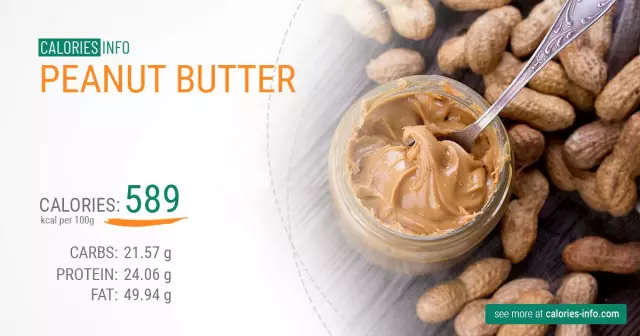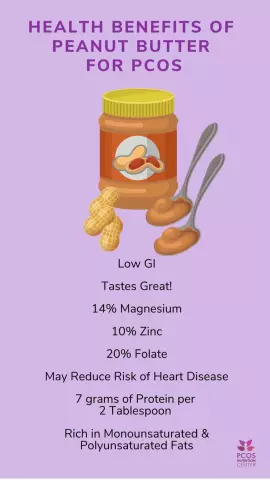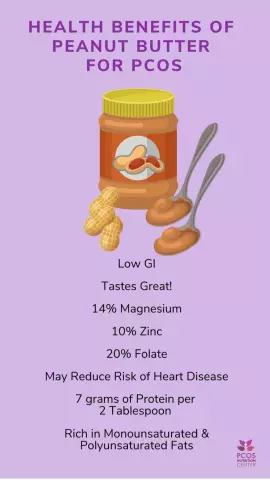- Author Rachel Wainwright [email protected].
- Public 2023-12-15 07:39.
- Last modified 2025-11-02 20:14.
Butter

Butter is a valuable source of animal fats. It is produced from cow's milk, and the fat concentration reaches 82% in the product, and up to 99% in ghee.
There are 4 quality classes of butter - extra, premium, first and second grade. To prolong the shelf life of the oil, salt may be added to it (its content should not be more than 2%).
Sweet cream butter is made from fresh cream, and sour cream butter is made from cream fermented with lactic acid ferments, which give the butter a specific taste. Vanillin, sugar, fruit juices, cocoa, honey can be added as fillers in the recipe for the preparation of butter.
The fattest varieties of butter are traditional (its fat content is up to 82.5%), amateur (80%) and peasant (72.5%).
The properties of butter must meet standard quality criteria - the butter must have a clean taste and smell, with no off-flavors, a dense consistency (small water droplets on the cut are acceptable), and a uniform white or cream color. In winter, butter has a lighter, whitish hue, and in summer it is more yellow, this can be traced to the dependence on the freshness of the grass that animals eat. If the butter crumbles when spread and cut, it means there is a lot of water in it.
Butter is served to the table to be added to cereals, mashed potatoes and other ready-made main courses, used to make sandwiches.
Ghee is made by melting butter at a temperature of about 80 degrees Celsius. It contains up to 99% fat. The appearance and properties of butter change after overheating - it becomes a rich yellow color, grainy in consistency.
Store natural butter in the refrigerator for no longer than 30 - 35 days. The packaging may indicate a longer period, most likely, preservatives and other fats are added to such oil.
The benefits of butter
The composition of butter contains up to 150 fatty acids. Most of these acids are saturated, but it also contains unsaturated fatty acids - arachidonic, linolenic and linoleic. Unsaturated fatty acids remove "bad" cholesterol from the body, and are also important for normal vision, for the functioning of the nervous system, for the health of the skin and mucous membranes.
The use of butter also lies in the fact that it is a source of fat-soluble vitamins - A, E, D, K. Vitamin A (retinol) supports the immune system to protect against pathogenic bacteria and viruses, it is a strong antioxidant, without it, full vision is impossible. Retinol is able to accelerate the healing of ulcers and erosions of the digestive system. Vitamin E is involved in the formation of sex hormones, restoration (regeneration) of damaged tissues, one of the antioxidants, maintains the beauty and health of hair, skin and nails. Vitamin D plays an important role in the metabolism of calcium and phosphorus, participates in the formation of bones and joints, and is a growth vitamin. Vitamin K affects blood clotting, increasing it.
Milk fats help the body absorb calcium, which is important for muscle function and bone building. The high calorie content of butter makes it an indispensable component in the diet of sick people, breastfeeding women who need rich sources of energy.
The harm of butter

There is a widespread belief about the dangers of butter as a source of cholesterol. In fact, if you consume oil in moderation, without overusing, then this product will do more good than harm.
It is known that up to a third of all cholesterol enters the body with food. Cholesterol in small quantities is extremely necessary for the body - it is included in the structure of all cell membranes, is an intermediate in the synthesis of sex hormones and vitamin D, and is important for strong immunity. There are studies proving the link between low cholesterol levels in the body and low human intelligence.
Excess cholesterol and saturated fatty acids, which are rich in butter, can contribute to the development of atherosclerosis, when plaques form on the walls of blood vessels that threaten to clog blood vessels and interfere with blood circulation. But it is also known that up to 2/3 of all cholesterol is produced by the body itself, which is already associated with the peculiarities of metabolism.
Serotonin receptors, sensitive to the "joy hormone" serotonin, cannot function properly without sufficient cholesterol in the blood, which also indicates the benefits rather than the dangers of butter. Butter is recommended for people prone to depression, bad mood and suicidal tendencies.
Calorie content of butter
Everyone knows that excess oil consumption can lead to weight gain, obesity and obesity. This is true, because the calorie content of butter is about 748 kcal per 100 g. The calorie content of ghee is even higher - 885 kcal per 100 g of product. To avoid adverse health effects of the oil, it should be remembered that the need for it is not more than 12 g / day, and do not exceed this amount.
Found a mistake in the text? Select it and press Ctrl + Enter.






